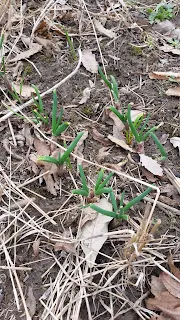 |
Looking up the strip of land that is being converted to hedgerow
|
 |
"Astro" Arugula was seeded last fall.
|
 |
Multiplier onions were planted near the damp end. Strawberry plants near the dry end.
|
 |
I found my horde of South Dakota plum seeds. These are from fruit that might have been pollinated by red-leafed, ornamental plums. You can see that some of the seeds are pushing roots.
|
 |
These were most likely pollinated by P. nigra. One or two peach pits may have snuck into the bag.
|
 |
These are assorted plum pits from grocery-store fruit. All those pits are planted.
|
 |
Dock, aka Sorrel aka Rumex is one of our earliest edible greens. The leaves are about two inches long. Slim pickings for foraged foods.
|
To date, I have the peach pits, the plum pits, the black currants, persimmon seedlings, hazelnuts, gooseberries, strawberries and multiplier onions planted into the hedgerow.
A fellow fruit-growing enthusiast graciously donated some elite selections of P. angustifolia or Chickasaw plum. Those will be propagated and thrown into the scrum.
For reference, many pear seedlings are very thorny and will remain thorny if you keep them juvenile by cutting them down. The species P. betulifolia stays very thorny longer than other species. P. bet is a commonly available rootstock.
Hawthorns (Crataegus monogyna and C. laevigata) are the foundation of European hedgerows, perhaps because those species propagate easily from cuttings and are thorny.
North America is home to many species of hawthorns. C. mollis is probably the pick-of-the-litter for edible northern species while C. opaca and C. aestivalis are good choices for the south. Opaca and aestivalis are typically identified as "Mayhaws" in the south. C. mollis is not available in the trade but one of its hybrids, Arnold Hawthorn can be found in older, city parks and the fruit tastes decent enough to make pies with. Brown sugar and cinnamon can work miracles.
Bonus image
 |
The calves gnawed the bark off these Black Locust branches. Black Locust retains thorns even as the branches grow. Some of those mouthfuls were prickly.
|








Is there a bustle in your hedgerow?
ReplyDeleteI had to look that up.
DeleteNo fruit, but everything else you would want in a hedgerow.
ReplyDeletePoincarus Trifolatica.
Numerous, long, strong tip rooting branches. Huge spines (2-3") all over. Certified as protective planting for nuclear instalations. Will stop a 6x6 truck. Known by P.T. which is an abreviation of it's name, Pain and Terror.
Trifoliate Orange is marginally hardy here. Cliff England sells some selections that originated in Korea.
DeleteI heard it is taking over Texas, as if there were not enough spiny plants and toads and things.
go rogue. informal. to start behaving in a way that is not normal or expected, especially by leaving your group and doing something dangerous: A Special Forces unit had gone rogue and was trying to free the hostage.
ReplyDeleteSounds like you are planting a feral food forest. I like it.
Osage Orange (aka hedge apple, aka monkey balls) was widely used as a hedge for farms prior to barbed wires. I think your approach of using food producers is probably the better way.
ReplyDeleteCockspur hawthorn, C.crus-galli, is the predominant native hawthorn here. Needle-like thorns. Will support grafts of Mayhaws(and other hawthorn species with larger fruits) - and some pears, but in my limited experience, pear-on-hawthorn is very much dwarfed.
ReplyDeleteI bought a packet of English hawthorn seeds to use as a flowering hedgerow in the silvopasture. A real long-term project - they say the seeds will take 1-2 years just to germinate.
ReplyDelete